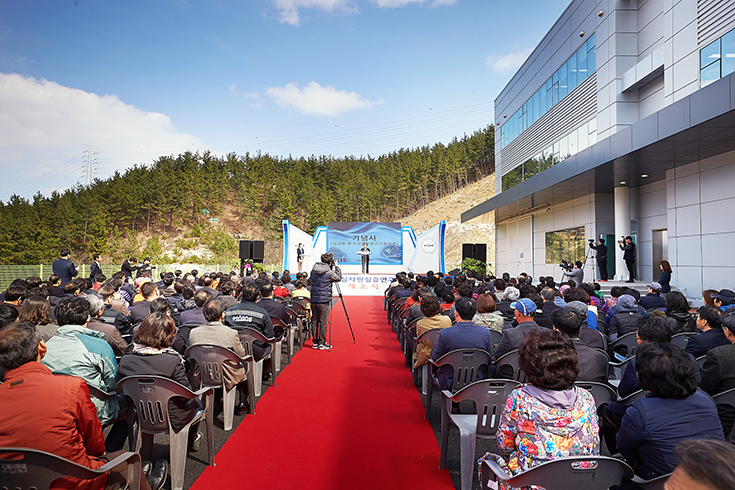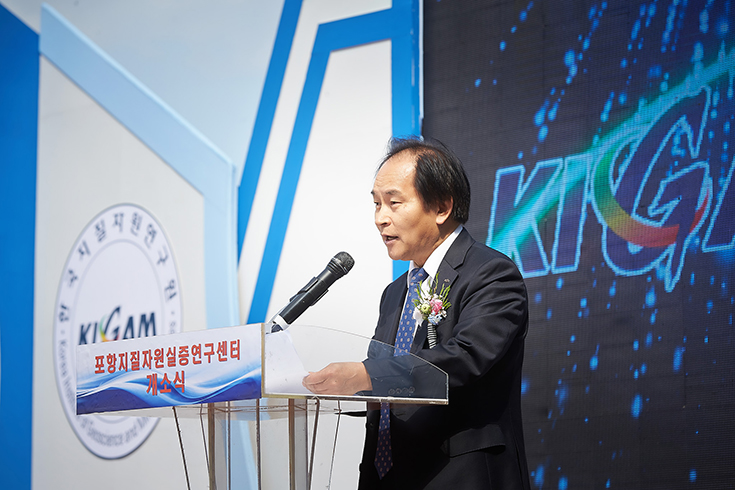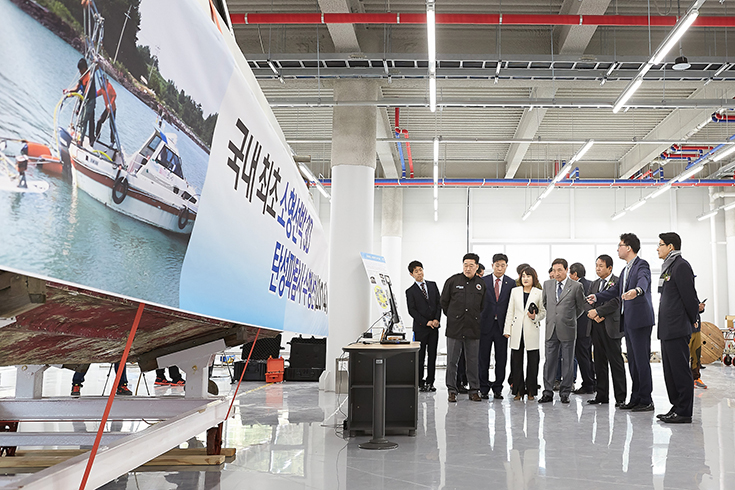- Nameadmin
- Date2016/03/29 00:00
- Hit437
Korea Institute of Geoscience and Mineral Resources (KIGAM)
Opens its Pohang Geological Resources Research Center
- An advanced base for exploring geological resources, domesticating resource plants, and developing new materials from clay minerals
- Dedicated dock for Tamhae II, a vessel for geological surveys of the seabed and exploration of energy and mineral resources

On March 24, the Korea Institute of Geoscience and Mineral Resources (hereinafter KIGAM, President Kyu-han Kim) held an opening ceremony at its new Pohang Geological Resources Research Center, located in Seonggok-ri, Heunghae-eup, Buk-gu in Pohang-si.
Attendees at the opening ceremony included Mr. Kyu-han Kim, President of the Korea Institute of Geoscience and Mineral Resources, Mr. Gang-deok Lee, Mayor of Pohang-si, Mr. Sang-chun Lee, Chairman of the National Research Council of Science & Technology, Mr. Myeong-jae Park, member of the National Assembly, Mr. Seong-ju Gang, head of the R&D Outcome Innovation Division at the Ministry of Science, ICT and Future Planning, Mr. Byeong-yun Jeong, Vice-Governor for Economic Planning in the Gyeongsangbuk-do Provincial Government, and Mr. Chil-gu Lee, Chairman of the Pohang City Council.
Pohang Geological Resources Research Center (hereinafter “Pohang Center”) has been established by the Korea Institute of Geoscience and Mineral Resources (KIGAM), a government-funded research institute under the aegis of the Ministry of Science, ICT and Future Planning which has played a central role in the research and development of Korea’s national geological resources. The purpose of the Pohang Center is to serve as an advance base for research and development (R&D) of future resources in the East-Sea Rim Zone, such as the development of new materials from mineral resources with high added value and convergence research of oil in the seabed.
The Pohang Center is located near the KTX Pohang Station, in Seonggok-ri, Heunghae-eup, Buk-gu, Pohang-si, on a site with an area of 76,000 ㎡. There are currently around 50 full-time employees working at the Pohang Center year-round, including the Center’s Director, Seong-pil Kim.
There were also five new employees of the Pohang Center hired through a public recruitment process earlier this year, who officially joined to the team at the opening ceremony. Seong-man Seo, a newly hired senior researcher, expressed his determination “to develop new material from geological resources and contribute to revitalizing the national and regional economy” through his research.
KIGAM chose to locate its research center in Pohang because of regional features unique to this area of Gyeongsangbuk-do and Pohang. KIGAM plans to exploit the locational advantages of its Pohang Center to undertake research of new materials from geological resources such as the clay minerals unique to this region, explore seabed geological resources and conduct geophysical surveys.

Notably, the Pohang Center is already engaged in research and development to utilize regionally specific mineral resources with high added value such as bentonite, which is distributed throughout the Gyeongsangbuk-do and Pohang region, as ingredients for new pharmaceuticals. KIGAM aims to build production facilities for pharmaceutical ingredients on a pilot scale within the Pohang Center that satisfies the GMP (Good Manufacturing Practice) standards and register domestic bentonite as a pharmaceutical ingredient, to utilize it as one of the key ingredients for developing new drugs in the future.
※ The region of Gyeongsangbuk-do and Pohang is known to have the thickest and broadest formation of Cenozoic tertiary deposits in Korea, where there is a strong likelihood of finding coal or oil deposits. The Pohang region is also a special source of mineral resources including bentonite, acid clay, zeolite, and diatomaceous earth, which are minerals with high economic value, with the potential to be utilized as food or pharmaceutical ingredients that have high added value.
In addition, the construction of mooring facilities dedicated to Tamhae II is scheduled to be completed in May. Tamhae II is a vessel used by KIGAM exclusively for 3D geophysical probes of the seabed. This construction will enable KIGAM to fully launch its projects for the exploration of marine geological resources and research and development based in Pohang.
Tamhae II is a 2,085-ton 3D geophysical exploration vessel with a boarding capacity of 37, first of its kind in Korea. It has been temporarily kept in Jinhae-gu, Changwon-si due to the lack of dedicated docking facilities, but once the proper facilities have been installed at the dedicated dock in Hanggu-dong, Buk-gu, Pohang-si, the vessel will use Pohang as its base for seabed explorations.

Meanwhile, the government is performing a preliminary feasibility review for the building of Tamhae III, envisioned as a new world-class geophysical exploration vessel that will used alongside Tamhae II, which has been in operation for two decades, since 1996. Once the building of Tamhae III is complete, research and development of the seabed geological resources will be undertaken in earnest, encompassing the Pacific Rim and Polar regions.
President Kyu-han Kim of the Korea Institute of Geoscience and Mineral Resources (KIGAM) stated, “The Pohang Center will be at the vanguard of securing the future resources and performing the practical development and industrialization of new technologies. To this end, it will develop the exploratory technology for marine geological resources, enable the domestic production of plants to develop future energy resources, and engage in research and development to develop new materials.” He continued, “We will build on the expert knowledge and experience we have accumulated in the field of geological resources over the course of the past century and do our best to make the Pohang Center a source of new growth in our nation.”